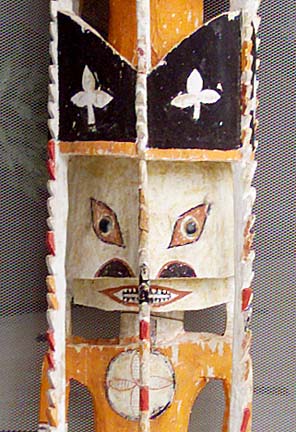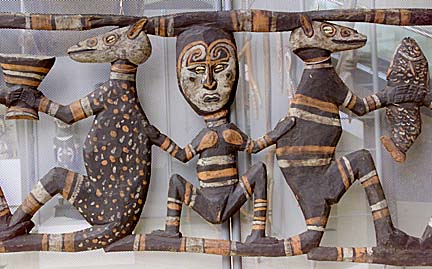


AS Donald Yacoe tells it, he was an aspiring 19-year-old artist clinging to his easel when he was drafted into the U.S. Army during World War II. Suddenly the Chicago art student found himself in the jungles of Papua New Guinea, a little apprehensive and bored, and about to stumble onto an entirely different artistic career.
Donald Yacoe's lifelong appreciation
for Pacific tribal art started
with a canoe paddleBy Suzanne Tswei
stswei@starbulletin.com"I was the staff artist with the Eighth Army, and I would go into the jungle to do watercolors (to record the surroundings.) I was really just a kid; I didn't know anything," Yacoe recalled.
He did know that he needed to be careful. He was at one end of Lake Sentani, where the American forces were stationed, while Japanese soldiers controlled the other end of the 25-mile-long lake famous as the only fresh-water lake containing salt-water flying fish.
"One day I was at one of the remote villages around the lake, and here comes this woman in a canoe with a paddle. I didn't know anything about Papua New Guinea art, but as an artist, I recognized (the paddle) was something with aesthetic quality," Yacoe said.
The wood paddle, with a carved curvilinear pattern representing ripples in the water, became the very first piece in his collection of Pacific tribal art. He acquired it by trading an Army-issued cigar for it.

"If I had known what I was doing -- later I found out Lake Sentani was an area rich with artifacts -- I would have gotten more things. But like I said, I was just a kid, and that was the only piece of art I got," Yacoe said.He also was afraid of getting in trouble with the law. The Dutch government, which ruled Papua New Guinea at the time, banned the trading of artifacts.
The paddle that he bought 50 years ago, as well the best pieces from a collection acquired since by him and his wife, Caroline, are on exhibit in the lobby of 1132 Bishop St. The Yacoe collection, primarily from the Melanesian countries of Papua New Guinea, Vanuatu and the Solomon Islands, is the inaugural exhibit marking a portion of the lobby in the red office building as a new gallery.
The exhibit opened yesterday and continues through Nov. 21. with a public reception tomorrow. The exhibit also features artifacts from Micronesia and Polynesia, and a handful of pieces from two other collectors.

After his Army stint, Yacoe returned to his original plan to become an artist without giving a second thought to collecting other art. He finished his education at the Chicago Institute of Art and became a successful painter, exhibiting his work in major cities and receiving commissions to paint murals in public places.The paddle followed him as he moved to Long Island and Southern California and finally to Hawaii, where he arrived as an exchange art professor and settled permanently after retiring from teaching.
"I always used that paddle to show my students that an utilitarian object can be an object of beauty. Tribal people give it aesthetic quality to give it a spiritual quality to make it perform better, to make it more powerful," he said.
In 1978, the Yacoes began their collection in earnest, spurred by Caroline's academic interest in the region. She studied for a master's degree in Pacific Island studies with a focus on Oceanic art while he was an exchange professor at the University of Hawai'i. The couple began to travel to remote Pacific islands in search of artifacts.

"When I was introduced to Oceanic art, I just love it. I want to encourage it, to get a wider recognition by other people. When it's recognized, it increases indigenous pride by the people who make it," Caroline Yacoe said."She's really the anthropologist of the family," Yacoe said. "She can tell you about the history and the culture and how to spell the words. I am the artist; I can see the aesthetic value. Between the two of us, we manage to pull off a pretty decent collection."
Pieces from their collection have been acquired by various museums, including the Honolulu Academy of Arts. Most of the artworks in the exhibit are for sale. They can be reached at 396-3326.
The couple also began documenting Pacific tribal culture on film. Their work has been shown in Hawai'i International Film Festival, and one film will be screened continuously at the exhibit.
"We are interested in areas where the traditional cultures are still being practice. The art is made as part of cultural practices, and it is more authentic than things that are made for sale to tourists," Caroline Yacoe said.

Collecting art from indigenous people depends on timing, a willingness to adapt to local culture and a sense of adventure, the Yacoes said."I had a few incidents where I felt like Indiana Jones where they are chasing me around with the drums going in the background," Donald Yacoe said, recalling an incident in which some village juvenile delinquents chased after him with a chain.
"But 98 percent (of the time) they are very nice to us and they are more than willing to cooperate. We've felt pretty safe," he said.
The most danger has come from mosquitos, which may carry malaria. The Yacoes always take preventive medicine and mosquito nets wherever they go.
Caroline Yacoe often finds herself an object of curiosity, with natives tugging at her platinum blond hair, and wondering what she's doing so far away from her native land.
"It's unusual for women to go off to do anything by themselves, and I often travel by myself. One time I heard that they were wondering what horrible thing I did for my husband to send me so far away," she said.
She makes sure when she goes that her thighs were covered at all times so as not to offend anyone. Even when swimming, she covers up with lava-lavas.

The Yacoes have become known in the region, and are welcomed by villagers on their collecting trips. The accommodations are simple: Sleeping on mud floors in thatched huts and eating a lot of boiled yams and taro."The most important thing I learned in all these years is if you see something you want, you have to get it or you'll never see it again," she said, recalling how the couple missed out on a piece of tapa when they visited Lake Sentani some 30 years after her husband bought the canoe paddle.
"Guess what happened. Here comes this woman (not the same women) in a canoe and she had this piece of beautiful tapa. I think she only wanted $5 for it, but Donald said no, it wasn't good enough for the collection," she said.
When they visited New York City afterward, they saw a similar tapa on display at the Metropolitan Museum of art.
"As soon as she saw that piece in the glass case, she turned to me and said 'you cheapskate.' I don't think she'll ever let me forget it," he said.
They saw the tapa in 1980 but have not been able to find another piece since then.
Place: Lobby at 1132 Bishop St. Pacific Visions -- Arts and Artifacts
When: 6:30 a.m. to 6:30 p.m. Mondays to Thursdays, 6:30 a.m. to 7 p.m. Fridays, 8 a.m. to 2 p.m. Saturdays through Nov. 21
Admission: Free
Call: 599-5009
Also: Meet collectors Caroline and Donald Yacoe at the reception, 4:30 to 6:30 p.m. tomorrow
Click for online
calendars and events.